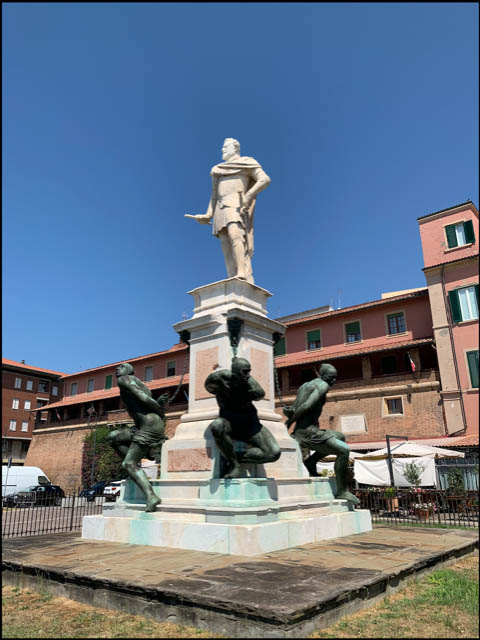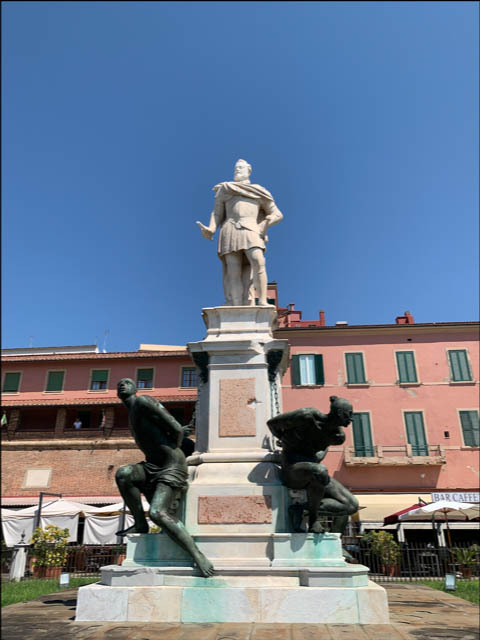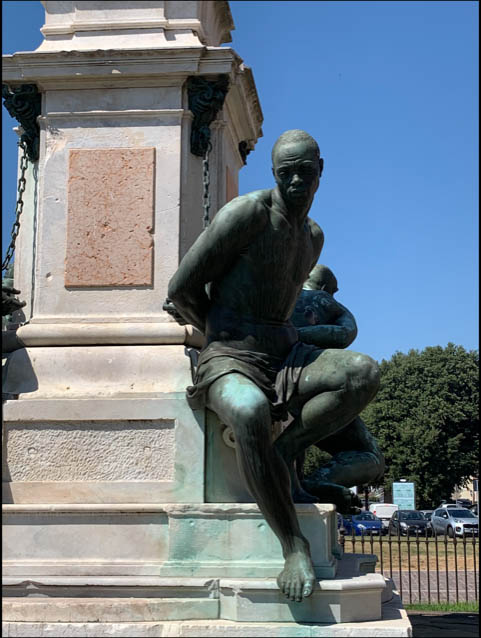Four figures of captured Africans in black and white marble support a massive triumphal arch on their shoulders. On white marble cushions rests the heavy construction with a sculpture of the doge Giovanni Pesaro in its center. flanked by four virtues — Fides, Fortitudo, Caritas and Justitia — the effigy states justice, faith and militant power as the virtues of the Venetian Republic under the reign of Giovanni Pesaro.1 With striking vividness the tomb seems to propagate the subjection of the black body in favour of the Venetian civilisation.
The literally black skin of the slaves, their round faces, full lips and swallowing round eyes encourage the assumption that what we see here is a typed representation of the so called ‘Sub-Saharan African’. Our perception today is materially influenced by the knowledge of images of Blackamoors in American and European popular culture, as well as the concrete exploitation of the black body during colonialism and slavery. The experience of Venetians in the 17th century, however, was considerably different to our postcolonial and post-slavery perception today. What nowadays generates emotions of horror and contempt, was meant to advertise a short reign that lasted merely one year from 1658 until the doge's death in 1659.2 The tomb was built in 1669, ten years after Giovanni Pesaro’s demise, according to the design of the famous Venetian architect Baldessari Longhena (1598-1682).3
The figures of the black slaves are by most accounts ascribed to the German sculptor Melchior Barthel (1625-1672) and relate, not to Africans captured in the transatlantic slave trade, but to the people enslaved in the war against the Ottoman Empire in defence to the island of Candia (today Crete) which was partly lead under Pesaro’s command.4 The weapons and armour which adorn the entablature suggest that the tomb in the shape of a triumphant arch refers to a victorious war. The iconography of victory, however, is a vast exaggeration of the truth, as Pesaro had not been considered successful in his defence of Candia and “ironically the island fell in the hands [… of the Ottoman; note from the author] in 1669, as the monument was completed”.5 Other than the slave’s de-humanising features might suggest the monument does not legitimise systematic exploitation of the black body equally to blackamoor iconography. Although the transatlantic slave trade had already started when the Pesaro tomb was completed, many more Europeans suffered enslavement in North Africa than has previously been commonly acknowledged.6 Venetian enslavement was such a common experience, that “both Ottomans and Venetians counted their imperial rivalry partially in terms of slaves taken and returned”.7
In 1669 Great Britain, which later became the most investigated in the transatlantic slave trade, lost more people to Ottoman enslavement than the other way around. The military strength of the Ottoman Empire rather suggests that the compositional subjection of the black marble slaves are meant to refer, or even constitute, a military strength that was strongly challenged in Pesaro’s lifetime. Unlike the blackamoor iconography, the grave is not to be understood as a visual manifestation of the transatlantic slave trade and colonialism, but postulates a militaristic superiority that was in fact strongly challenged.
Although the black marble slaves in Venice precede blackamoor imagery and its historical context, one cannot disconnect our perception from the traumatic history that would follow. It is hard to overlook the de-humanising effect of the eternally oppressed African sculptures and not to remember the disturbing past of systematic enslavement and its visual representation in de-humanising blackamoor imagery. Even if compared to another massive monumental sculpture featuring Africans as captives the black marble slaves remain singular in their artistic strategy of de-humanisation of the black body.

© Leonie Chima Emeka
Giovanni Bandini, Grand Duke Ferdinando I de' Medici 1597-99,
marble, and Pietro Tacca, I quattro Mori, 1621-26, bronze, height 33 ft. 3 in. (10.14 m)

© Leonie Chima Emeka

© Leonie Chima Emeka
Pietro Tacca, I quattro Mori, 1621-1626, Piazza Micheli, Livorno
The Monument to Grand Duke Ferdinando I de' Medici in Livorno, Tuscany, is considered the first public monument in early modern Italy to depict enslavement of the black body as a violent act and might have served as a model for the black marble slaves in Venice.8 The four bronze figures were manufactured in 1626, only 33 years before the Venetian sculptures, by Pietro Tacca. The four Livorno slaves are in fact a later addition to the monument of the likeness of Ferdinando I. Grand Duke of Tuscany.9 Tied to the pedestal they are meant to be understood under the control of Ferdinand I. It is the slaves’ strength and the explicitly forced subjection of these muscular bodies that indicate the elegant but lean Ferdinando I as a strong, assertive and powerful figure.
The four attributes of power completed in Pesaro’s youth, might have offered an alluring imagery for the later Doge, who had been highly criticised and actually taken to court for his military actions in defence of the Isle of Crete.10 Also the Venetian slaves represent physical strength as they support the massive tomb on their shoulders. The round eyes and big lips in the grimacing round faces which are contorted to an almost animal expression, however, mark the Pesaro slaves as hideous beings. The Venetian Slaves surpass their models in Livorno transcending the degree of de-humanisation to evoke the impression of the African slave as inferior. The slaves in Livorno, who wear a challenging or defeated expression, invite sympathetic emotions while the Venetian figures are deformed to almost caricatures. The status of dominance and subjugation is already apparent in the Venetian figures themselves. Not the presence of the chains, nor their mere position marks them as victims of subjection. It is rather indicated that the subjection is already incorporated in their hilarious features. In presence of the Pesaro slaves one cannot help but feel the uncomfortable impression, that it is the slaves themselves, their explicitly depicted inferiority, which legitimises their enslavement. Barthel’s artistic strategy of de-humanisation marks a shift in the representation of the black body in European imagery. If racism is defined as the naturalisation of the inferiority of the black body it concludes: the Monumento al Doge Giovanni Pesaro is a racist monument before systematic racism.
Footnotes
1 Identification of virtues: da Mosto, p.250.
2 Da Mosto, p.253f.
3 Da Mosto, p.251. Longhena’s plan can be found in the Zentralinstitute für Kunstgeschichte in Munich.
4 Ascription and life dates: Kaplan, p.186. Residency in Venice and Ascription: De Mosto, p.251.
Ascription to Ottomans and War of Candia: Da Mosto, p.238, p.249, p.253. Kaplan, p.186.
5 Kaplan, p.186. Although Kaplan and De Mosto name “Turks”, I chose the term Ottoman according to Lowe’s statement, that the term ‘Turks’ was often used to describe the whole Ottoman Empire. Da Mosto, p.253.
6 Davis, p.87ff.
7 Rothman, p.429
8 Rosen, p.38.
9 Construction of pedestal and sculpture: 1597 and 1599 by Giovanni Bandini ibid., p.38.
10 Da Mosto, p.254.
published July 2020




